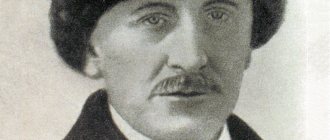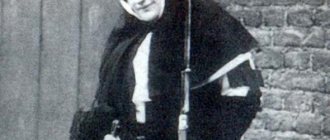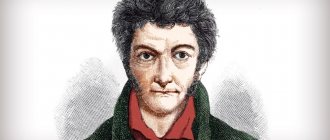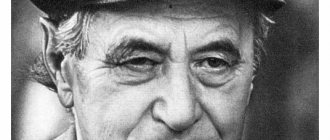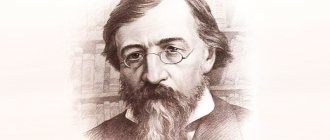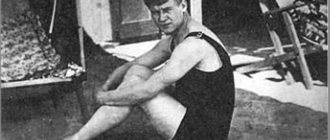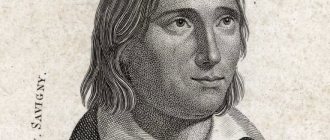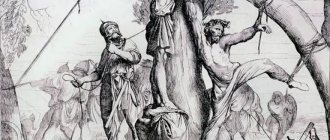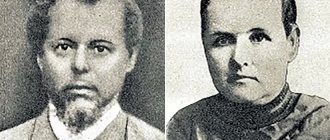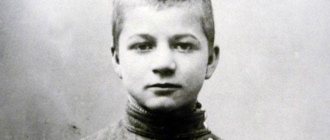Emelyan Pugachev: biography
Emelyan Ivanovich Pugachev - leader of the popular uprising and the Peasant War of 1773-1775. An impostor posing as Emperor Peter III.
The future rebel was born in 1742 in the village of Zimoveyskaya (now Volgograd region) into the family of a Don Cossack. The people inhabiting the lands of the Don region had a freedom-loving disposition. 110 years before Emelyan’s birth, his predecessor, Stepan Razin, was born here. Pugachev’s grandfather bore the nickname Mikhail Pugach, which formed the basis of the family name. The family of the boy’s parents, Ivan Mikhailovich and Anna Mikhailovna, also raised a son, Dementy, and two daughters, Ulyana and Fedosya. The Pugachevs professed Orthodoxy, unlike their fellow Old Believers.
Portrait of Emelyan Pugachev
In 1760, the young man enlisted and immediately found himself in a military campaign against Prussia. Periodically visiting his relatives, Pugachev attended the battles of the Seven Years and Russian-Turkish Wars. After 10 years, Emelyan was elevated to the rank of standard bearer, but after serving in this rank for a year, he went on the run to the foothills of the North Caucasus. This opportunity arose after an infectious disease, which caused him to be sent home. Having recovered, Emelyan meets with his sister’s husband and persuades S. Pavlov to become deserters.
Examples of essays on the topic “The image of Emelyan Pugachev in “The Captain’s Daughter” by A.S. Pushkin
Example of essay No. 1 The theme of the popular uprising led by Emelyan Pugachev is one of the central ones in the story by A.S. Pushkin "The Captain's Daughter". The leader of the rebels, who named himself after the deceased Tsar Peter III, is depicted in the work as an extraordinary and contradictory personality. The attitude towards him is ambiguous.
For the first time we meet the future chieftain, when he has not yet managed to gather the rebels around him and become the head of their uprising. He accidentally meets on the path of the main character of the story, Pyotr Grinev, and helps him find his way into the snowstorm. The author describes him as a short and thin man with broad shoulders, a black beard and a lively, roguish look. He is savvy and has the instincts of a predator. For his help, Pyotr Grinev gave the guide his sheepskin coat, and Pugachev did not forget this goodness, as he promised.
At the next meeting, during the reprisal against the defenders of the Belogorsk fortress, Pugachev appears before the reader in the form of an ataman, who called himself a king and led a popular revolt. He mercilessly deals with everyone who refuses to swear allegiance to him. However, he has mercy on Grinev, remembering his goodness, despite the fact that the young man honestly says that he will not serve him and even plans to fight the rebels, as his duty as an officer tells him.
In the story “The Captain's Daughter” Pugachev is ambitious and proud. He is not literate, but he hides it skillfully. On the other hand, he is not stupid, he spouts folk sayings, he understands that he is doomed. At the same time, he knows how to value nobility, so he helps Grinev save Masha and talks to him frankly. He adheres to the principle: “Execute, so execute, have mercy, so have mercy.”
Pugachev’s position in life is reflected in the Kalmyk fairy tale about an eagle drinking living blood and a raven feeding on carrion. He believes that it is better to live free for a short time than to spend many years in slavery.
As a person, Pugachev evokes the sympathy of the author, played by Grinev, but he does not approve of his actions, characterizing the riot as “senseless and merciless.”
The image of Emelyan Pugachev, created by A.S. Pushkin in the story “The Captain's Daughter” makes us think about the ambiguity of historical figures who can be good people in life and cruel leaders in politics. Life is complex, and not everything in it can be divided into black and white.”
Essay example No. 2
Emelyan Pugachev is one of the main characters of the story “The Captain's Daughter”. This image is based on the historical figure of the same name - the Don Cossack, who led the popular uprising of 1773-1774. Traditionally, Pugachev is considered a cruel and bloody robber, on whose conscience there are many ruined lives. However, in the story by A.S. Pushkin also reveals other facets of this complex image, such as generosity, the ability to remember goodness, and honesty.
Description of the hero
First meeting
Young Grinev and his servant Savelich are heading to Orenburg.
On the way, they get caught in a terrible snowstorm and lose their way. Among the snowstorm, they distinguish the figure of a traveler (none of them yet knows that it is Pugachev), who accompanies them to the inn. This chapter is symbolically called “Counselor”, because this person will play the role of a kind of guide in Petrusha’s life. In gratitude for saving him, Peter gives him a hare sheepskin coat. The self-control that Pugachev retains when he finds himself in a stormy steppe at night is amazing: “The road is here,” he says, “I’m standing on a solid strip, but what’s the point?.. Look, what the weather is like... It’s better to stop here and wait, maybe the storm will subside , may the sky clear up: then we will find our way by the stars.” This confidence is naturally transferred to young Grinev. After all, Pugachev was in fact an amazingly persistent and fearless person, capable of inspiring trust and subjugating almost anyone to his influence. In the conditions of winter cold with a blizzard, where the lives of travelers were in real danger, this composure of the guide inspired peace and confidence. His courage was largely explained by his Cossack origin, his habit of overcoming any difficulties, and his resourcefulness.
Pugachev had the ability to determine the path by the stars, with some special instinct to catch the smell of smoke and to find housing by the blow of the wind. Grinev immediately noticed all these qualities in his guide, and his advice helped him avoid a fatal ending.
Appearance
Pugachev's age is approximately forty years. His dark hair is cut in a circle, and his long beard has glinting silver hairs. In his big eyes you can see a hidden roguish spark. During a conversation, it is the eyes that betray the emotions overwhelming him: regret, a grin or complete complacency. The hands are large and working, like those of a manual worker. Pugachev is thin, despite his broad shoulders. When Peter gives him a hare fur coat, Savelich laments that it will not fit on his huge “shoulders”. When communicating with people, Pugachev behaves calmly and measuredly. Overall, this person makes a pleasant impression.
Character traits, behavior, speech
Pugachev was completely illiterate; he could neither read nor write.
On Pyotr Grinev’s pass, instead of a signature, he put ornate “scribbles.” Apparently ashamed of his lack of education, he always called the Obersecretary when he needed to read some documents. His speech is simple, peasant-folk, without complex structures and phrases. He knows countless proverbs and sayings and skillfully inserts them into conversations, and he is also an unsurpassed storyteller of ancient tales and legends. In the Belogorsk fortress, Pugachev appears dressed in expensive and elegant clothes. “He was wearing a red Cossack caftan trimmed with braid. A tall sable cap with golden tassels is pulled down over his sparkling eyes.” The leader of the peasants, who cares about their protection from the oppressive landowners, himself does not disdain easy money, money, loves to dress up and at least temporarily feel like a gentleman. Another trait of Pugachev is pride. Telling the parable of the eagle and the raven, he concludes: it is better to drink fresh blood once and die than to live for three hundred years and eat carrion.
Pugachev's attitude towards people
Pugachev hates the authorities and considers as enemies those whom he sees as oppressors of the people.
In relation to such people, the cruelty and mercilessness of his nature are manifested. He also does not show mercy to those who do not want to recognize him as a sovereign. As a result of disobedience to him as a tsar, he sends to death Ivan Kuzmich, the commandant of the fortress and his faithful friend Ivan Ignatievich. His bandits brutally deal with Vasilisa Egorovna and many other inhabitants of the Belogorsk fortress. In essence, Pugachev was a lone rebel; in his circle he did not see people truly devoted to him. That’s why he relied mainly on the Russian “maybe.” He deeply doubted that he would be able to reach Moscow, because he knew that his army were former thieves and robbers who, at the first defeat, “would ransom their heads with his neck.” But he had no choice but to continue moving forward, since he understood that it was too late to repent. He also realized that he would not be able to fool the authorities for a long time, so he clearly understood that inevitable punishment awaited him ahead for all his atrocities.
The explosive and capricious Pugachev, who in moments of anger terrified with his mere glance, could be generous and humane to those who treated him sincerely and with trust. In this sense, the example of his grateful attitude towards Grinev is indicative. He did not forget about the hare's sheepskin coat, nor about the glass that young Peter offered him at the inn. For this, he subsequently spared Grinev just before his execution, then released him from captivity, rescued his beloved Masha and was not at all angry with Savelich, who publicly called him a villain.
It is noteworthy that Pugachev, who literally saved Grinev and Savelich during a snowstorm, accepts the hare sheepskin coat not as a sign of gratitude for the rescue, but as a generous gift, which seems to oblige him to gratitude. This is evidenced by his words addressed to Grinev: “I will never forget your mercies.” He does not forget about his promise: young Grinev tests his fate three times, and all three times Pugachev has mercy on him. Even after in a private conversation Grinev finally refuses to swear allegiance to him, Pugachev says: “So be it, execute so execute, have mercy so have mercy. Go ahead and do what you want.” This is how Pugachev’s broad soul manifests itself, which is alien to pettiness and vindictiveness.
The role of the hero in the work
Through the image of Pugachev A.S. Pushkin recreated the whole truth of life in its realities. He described the hero himself as he really was; Pugachev seemed to live a second life on the pages of his story. The vivid image of this hero in “The Captain's Daughter” is drawn in strict accordance with the historical image of Pugachev, with the accompanying phenomena of the 18th century, with the everyday features of those regions where Pugachevism originated. Despite the fact that Pugachev personified a “senseless and merciless” rebellion, Pushkin protected his image from misinterpretations and lies. From the legend woven from the bloody atrocities of this man, he managed to isolate the purely folk and recognizable features of the dashing and rogue Cossack vagabond, as well as human gratitude and nobility.
Character development as the story progresses
Pugachev appears in the story in the form of an unknown traveler, who later became the source of a great disaster.
It is this hero who is assigned the role of the one who divided the life of the Belogorsk fortress into “before” and “after”. If at the beginning of the story he represents something not entirely clear, then from chapter to chapter his image fills the entire plot of the work. The changes that occur with this character in a short period of time are also indicative. From a simple roguish and savvy peasant, he turns into a cruel and unforgiving man who is ready to fight for the sake of the goal that he has set for himself. He has faith in what he stands for, and this faith is passed on to the people who consider him a hero. He is confident to the last that the people are able to defeat the government, and in this case a happy and free life awaits them.
Already from the middle of the work, Pugachev begins to realize that he is none other than an impostor. He comes face to face with doom and lives only with illusory hope for the future. Pushkin leads the reader after the rebel, who is still winning victory after victory and leads him to the farewell scene with him already on the scaffold. The author brings this finale closer step by step and, despite the triumphal march of his hero, hints at the inevitability of his tragic end. He unusually vividly conveys the purely Christian state of Pugachev just before his execution in his address to the people and in his bows to Moscow cathedrals. The last words of the eagle, who longed to drink fresh blood, were a request for forgiveness: “Forgive me, Orthodox people; let me go where I was rude to you... forgive me, Orthodox people!”
The author's attitude towards the hero
In the image of Pugachev, Pushkin managed to embody those traits of the Russian man that he valued most: wisdom, breadth of soul, strength, courage.
Sympathizing with his hero, the author describes him as the owner of a contradictory character, in which the positive is adjacent to the dark and bad sides of his soul. He is impartial towards Pugachev, sweeping aside political and class prejudices. He has no goal of whitewashing this person, washing away the blood of innocent victims from her, but underneath this lies admiration for her daring courage and noble deeds. Pushkin managed to look so deeply into the soul of this robber that, under the villain’s appearance, Russian good nature, gaiety, and nobility were revealed to him. Essay example No. 3 Emelyan Pugachev in most cases has negative character traits. He is self-confident and proud.
His image is characterized by cruelty. In the novel, Pushkin does not indicate specific examples of his cruelty. This quality of his character is revealed in the comments of other characters, often conveyed to the reader through Grinev. So, for example, the young man claims that those around him considered Pugachev “a terrible person, a monster, a villain.” The rebel is a deceiver and a rogue - he is not embarrassed by his lies, in fact, he does not see anything shameful in them.
Going to Pugachev to free Masha, Grinev “remembered the reckless cruelty, the bloodthirsty habits” of his beloved’s savior.
At the same time, Pugachev’s heart is not alien to pity and humanity - he is imbued with sympathy for Grinev and contributes to the release of Masha Mironova, does not execute Grinev himself after refusing to serve him.
Pugachev successfully plays the role of an educated, well-mannered person (at least among his associates). He pretends that he can read and write, although in fact he is not taught to read and write. “Our bright eyes cannot make out anything here. Where is my chief secretary? - he says to hide this fact.
An important element in his life remains the presence of freedom. He is a freedom-loving person. Apparently, Pugachev is not distinguished by gastronomic biases, but he has an exorbitant appetite. He can eat two piglets in one sitting. He also loves to drink and calls tea not a Cossack drink.
Pugachev is able to sensibly assess his capabilities. He realizes that his actions are negative, since they have acquired destructive power, but he no longer has the opportunity to correct everything - his rebellion has become too widespread.
Pugachev's appearance
A. Schopenhauer was convinced that a person’s appearance plays an important role in his characteristics.
It is thanks to appearance that one can determine such character traits of a person that are not noticeable at first glance. Pugachev does not have exceptional appearance. In most cases it is quite typical, although it is not without interesting moments. Seeing Pugachev, Grinev examines him with curiosity and finds him “wonderful.” The people's avenger looks like this: he is of average height, thin in build, but broad-shouldered. There are scars on his body, Pugachev himself calls them “royal signs.”
He looks to be about forty years old. Pugachev wears a long beard. His hair is dark, but his beard is already streaked with gray. His hair is cut into a circle.
His eyes are large, and there is something roguish about them. Pugachev’s eyes are very lively; they “run around” during a conversation.
His hands are typical of a working man - large and sinewy. In general, Pugachev is a pleasant-looking person. In his manner of behavior and communication with people, calm and measuredness can be traced.
There is canonicity in Pugachev’s appearance - despite the fact that in Pushkin’s work he is shown mainly in the role of a robber, the reader is imbued with sympathy for this character.
Villain or protector?
The complexity and ambiguity of Pugachev’s actions created a dual perception of him on the plane of “villain” or “intercessor”.
Alexander Sergeevich managed to successfully demonstrate the fact that not a single person has the same type of character and that positive and negative personalities coexist in any person. Of course, Pugachev is significantly inferior in his manners and nobility to, for example, Robin Hood, or (according to critics, not the most successful literary character of Pushkin) Dubrovsky. As is typical for all representatives of the peasant class, Pugachev is not distinguished by education and royal manners. His behavior is corrected by folk morality and generally accepted, “unspoken” rules of behavior.
From the point of view of the masses, Pugachev is naturally a savior - liberation from serving the landowners and their oppression in various fields of activity has the best influence on his historical role in the life of the peasants.
Mutiny
The reason for the rebellious sentiments to which Emelyan Pugachev was subjected was the adoption in 1762 of the imperial decree “On the liberties of the nobility.” Serfdom was legally established for another 100 years. At that time, free settlements of the Cossacks, merchants and fugitive peasants grew on a large scale throughout Russia. The forced people yearned for freedom, but their situation did not change. A conflict was brewing between the oppressed sections of the population and the landowners. Pugachev, as a spokesman for people's ideas, took on the position of a leader who managed to temporarily get closer to the peasant dream of a free state.
Emelyan Pugachev
Emelyan Ivanovich constantly migrates, never staying in one place for a long time. Often a Cossack resorts to lies, calling himself an Old Believer or a schismatic when necessary, but he himself often resorts to pagan rituals. In three years, Pugachev visited Chernigov, Gomel, the Polish lands, on the Irgiz River, lived in the villages of the Terek Cossacks and Nekrasov Cossacks.
In 1773, after an unsuccessful rebellion, Pugachev was arrested and, by decision of a secret meeting on cases of high treason, sentenced to lifelong hard labor in the village of Pelym. But he successfully escaped from prison in the summer of the same year.
Military service
A more or less traceable biography of Emelyan Ivanovich Pugachev begins in 1759, when he entered military service as a Cossack, participated in the war with Prussia (1756−1763), where for a long time he was an orderly of Ataman Denisov. In 1764 he fought in Poland, then went to the Russian-Turkish War. In 1770 he received the title of cornet; a year later, due to illness, he wanted to resign, but was refused.
He was advised to receive treatment in his native place and then return to duty. Emelyan went to his sister and brother-in-law in Taganrog . The son-in-law, also a soldier, was preparing an escape at that time, being dissatisfied with the conditions of service. Pugachev offered him his help, but the escape failed, and all its participants ended up in prison.
I had to run. First, his path lay to the Cossacks on the Terek, then beyond the Kuban to the Nekrasov Cossacks, then to Poland, from there he went to Chernigov and lived for some time among the Old Believers, then moved to Gomel, and from there to the Mechetnaya Sloboda on the Irgiz River. He was periodically captured by the authorities, but each time he escaped from captivity .
It is known that in most cases he was arrested for filing petitions from peasants. This largely explains the events of his later life and the formation of his personality.
Insurrection
Emelyan heard about the suppression of the uprising of the Yaik Cossacks and hurried to the Urals to impersonate Peter III and become the head of the Cossack army as the deposed emperor. Pugachev decided to gather a strong army in order to break through to the free lands of Transkuban and settle there with the Cossacks. Companions I.N. Zarubin-Chika, M.G. Shigaev, T.G. Myasnikov, D.K. Karavaev, M.A. Kozhevnikov prepared a legend for the leader and began to call the ataman Peter III.
The dashing Cossack dreamed of creating a free Cossack-peasant kingdom, headed by a peasant king. Pugachev’s naive views found a response in the hearts of the dissatisfied Cossacks and depressed peasant people.
Self-proclaimed Tsar Emelyan Pugachev
Pugachev goes to the main goal, using violence, outrages, and unreasonable terrible reprisals against landowners and the military. Because of robberies and robbery, the Don Ataman’s detachment was often called a gang. Historical sources disagree on whether Pugachev was a welcome guest in the cities and villages he visited, or whether the people were afraid of the rebel. Due to the concealment of documents on the Pugachev rebellion for more than 200 years, many facts are still hidden from historians.
Cossack or Tsar Peter III
Pugachev hints that he is a Cossack. “Tea is not our Cossack drink”
, the rebel said to Grinev, asking for a stronger drink.
The letter received by Ivan Kuzmich indicated that a real schismatic, Don Cossack Emelyan Pugachev, had escaped from custody. “He christened himself with the name of the late Tsar Peter III. He gathered a huge gang consisting of peasants, convicts, thieves and murderers. He created an indignation in the Yaitsky villages, and has already taken and destroyed several fortresses, carrying out robberies and capital murders.”
.
He often talks about his love of independence. “God knows. My street is cramped; I have little will"
. He compares himself to a free eagle, which, compared to a raven, lives little, but drinks fresh blood and does not feed on carrion.
Next, his plans include Orenburg. When he releases Grinev there, he asks him to tell the authorities to wait for him and surrender with obedience without a fight, otherwise they will not escape severe punishment. And after that, he intends to take aim at Moscow.
Peasants' War
A large military offensive by Pugachev’s troops was planned for the autumn of 1773, which was to be supported by the serfs. Emelyan also relied on the national communities of Bashkirs, Tatars, Kalmyks, and Kazakhs dissatisfied with Russian rule, thereby popularizing hatred of the Russian government. In carrying out military operations, the Russian impostor was helped by the hero of the Bashkir people Salavat Yulaev and his army.
Pugachev holds court in Kazan
In the winter of 1773, the impostor managed to gather an army of 25 thousand, whose arsenal included 86 cannons and supplies from military Ural factories. At the head of the military organization was the Council, which dealt with the settlement of military, political and social issues within the rebellious Cossacks. Pugachev’s “Secret Duma” was located in the Berdskaya Sloboda, whose emissaries distributed manifestos with tempting promises on behalf of Emperor Peter III throughout all captured volosts.
Map of the uprising of Emelyan Pugachev
Despite Pugachev's obvious organizational merits, he made a number of strategic mistakes that influenced the outcome of the uprising. The first city that the rebels took was Yaitsky town, then Orenburg fell. Having cleared the northern territories, Pugachev captured weapons factories, thereby providing the army with artillery. An equipped army of thousands of Cossacks descends to the lower reaches of the Volga, meeting people welcoming the Tsar in all occupied cities.
Pugachev's court. Artist Vasily Perov
Pugachev succeeded in his victorious march due to his promises to abolish serfdom and reduce taxes. The territory covered by the uprising grew from Western Siberia to the Perm region, Tambov province and descended to the lower reaches of the Volga. Pugachev captured the cities of Saransk, Penza, Saratov, Chelyabinsk, Ufa, Krasnoufimsk. The ataman established power in the Magnitnaya, Karagay, Peter and Paul, Stepnoy and Trinity fortresses. But the Volga region fortifications left in the rear become a springboard for government troops to respond to the rebels.
At the end of the summer of 1774, Michelson's army defeats the Cossacks near Tsaritsyn, putting the enemy to flight towards the Caspian coast. For 100 thousand rubles, Pugachev is betrayed by his comrades F.F. Chumakov, I.P. Fedulev and I.A. Tvorogov, and in the steppes of the Trans-Volga region, near the Bolshoi Uzen River, the leader of the uprising is arrested.
Arrest of Emelyan Pugachev
Pugachev is placed in a cage in which it is impossible to straighten up to his full height, and in this form, under the personal escort of Alexander Suvorov, he is taken to the capital. The case of the impostor and his henchmen is being investigated in a closed Senate court. The death sentence is agreed upon personally with Empress Catherine II. In addition to Emelyan Pugachev, his comrades A.P. Perfilyev, M.G. Shigaev, T.I. Podurov, V.I. Tornov are sentenced to quartering.
Execution of Emelyan Pugachev's associates
The result of the hostilities of the Peasant War was the destruction of more than 3,000 noble families and 60 Ural factories. Military fortresses were destroyed, Orthodox churches were looted and destroyed, cities were burned. Pugachev's Cossacks mercilessly slaughtered government officers and raped their wives and daughters. The rebels killed priests, as well as ordinary people, sparing neither infants nor the elderly. The crimes were made public at the trial. Pugachev never achieved his goal, becoming mired in bloody crimes.
Execution of Emelyan Pugachev
The Peasant War truly frightened the ruling elite of the Russian state. The government and, above all, Tsarina Catherine II took extreme measures to eradicate the memory of the rebels among the people. The village in which Emelyan was born was moved to another place and received the name Potemkinskaya. The Yaik River was renamed the Ural, and the Yaik Cossacks were renamed the Ural Cossacks. The Zaporizhian Sich ceased to exist forever as a free entity potentially dangerous for the state power. Many Cossack settlements were moved away from the center and fragmented.
Personal life
In 1760, Emelyan Pugachev married Sofya Dmitrievna Nedyuzheva, a native of the village of Esaulovskaya. But soon the newlywed was sent to war with Prussia, and his wife was left in the care of his parents. After the Cossack’s short-term return to his homeland in 1764, the first-born son Trofim was born into the family. Subsequently, Sophia gave birth to several more children, but only the daughters Agrafena and Christina, born in 1768 and 1770, survived. After Pugachev fled to the Yaitsky Cossacks, he finally broke ties with his wife and children and began to lead a free lifestyle.
Emelyan Pugachev and his wife Sophia
At the beginning of 1774, having arrived in the Yaitsky town, Emelyan Pugachev drew attention to the young girl Ustinya Kuznetsova, the daughter of a local Cossack, who was at most 17 years old. Pugachev sent matchmakers to the bride’s house several times, but was refused each time. Finally, the ataman decided to take possession of Ustinya by force and cunning, and already in early February the wedding took place in the local church.
After the wedding, the girl settled in the “royal chambers” and could not deny herself anything. But Ustinya was still burdened by her own situation. Marriage to a simple Cossack woman weakened the atamans’ trust in Pugachev, as the named emperor, and struck distrust in his person, which ultimately led to betrayal.
Emelyan Pugachev and his wife Ustinya
After Pugachev’s arrest, the first family and Ustinya Kuznetsova, despite the fact that they were found innocent, went into exile to the Kexholm fortress, where they were kept in prison conditions for the rest of their lives. Catherine II, even after a while, did not cancel the verdict.
Historical aspect in the image depiction
Emelyan Pugachev is a real historical figure. His image became one of the key ones in the context of the 18th century. In the story by A.S. Pushkin does not go into detail about the image - very little attention is paid to his appearance and details of his biography, however, the key elements in Pushkin’s narrative are depicted within the framework of authenticity.
Like any other work of fiction, the story contains a share of literary hoax. In the image of Pugachev she also exists. Not a single chronological summary contains one hundred percent information about a particular character. In a work of art, the author imagines the character’s gestures, facial expressions, pantomime, his monologue and dialogic speech based on his general historical assessment of the personality.
In general, Pushkin managed to recreate a holistic image of a people's rebel, but it did not fully correspond to the framework of reality.
The historical Pugachev was deprived of that share of nobility and kindness that Pushkin attributed to him. During the capture of fortresses, Pugachev and his associates behaved extremely inhumanely. So, for example, having captured the Tatishchev fortress, the commandant’s skin was torn off, and the robbers smeared his wounds with his fat, his daughter was taken as a concubine by Pugachev, and later killed along with her seven-year-old brother. Pushkin does not describe such a Pugachev in the story - cruel and merciless.
Relationship with the image of Taras Bulba from Gogol's story
Pushkin’s “The Captain’s Daughter” has a certain connection with Gogol’s story “Taras Bulba”. The semantic content and allusions in the works make it possible to confidently determine their identity.
To some extent, we can talk about the influence of Gogol’s story on the artistic basis of Pushkin’s novel.
Although the main array of similarities falls on the images of Ostap, Andrei and Grinev with Shvabrin, one can note some similarity in the images of Bulba and Pugachev. Both the first and second come from the Cossacks. Both of them, resisting noble oppression, take, from the point of view of the state, the criminal path. These images also have similar personal traits - both Cossacks have a tough character, they are ready to pay any price to achieve their goals, their character is characterized by unbridledness and hot temper. Their image is based on the struggle against lawlessness. At the end of the work, both Bulba and Pugachev die a violent death.
Pushkin about Pugachev
The history of the rebellion led by Pugachev was hidden by the government for many years, but the image of the hero was kept in the memory of the people. One of the first researchers to become interested in Pugachev’s personality was Alexander Pushkin.
Alexander Sergeevich Pushkin
The writer created two literary works dedicated to Emelyan Ivanovich: “The History of Pugachev” and “The Captain’s Daughter.” In the first essay, the author describes the actions and deeds of the brave rebel, based on all the information known at that time. The second work is written in artistic language, but the characterization of Pugachev in it is correct, which was confirmed by documents released later.
Interesting Facts
- In addition to Stepan Razin and Emelyan Pugachev, another rebel revolutionary Vasily Denisovich Generalov was born in the village of Zimoveyskaya. The Cossack became involved in the preparation of a terrorist attack to eliminate Emperor Alexander III, but the operation was unsuccessful and the conspirators were arrested. The generals were executed in the same way as their predecessors: the young man’s head was cut off.
- Catherine II hid information about the Pugachev uprising from Europeans. But the German ambassador Count Solms noticed the absence of black caviar in the capital's markets and made the correct conclusion about the conduct of military operations on the Volga.
Emelyan Pugachev
- It is assumed that Emelyan Pugachev collected countless treasures of the eastern khanates. The rebel’s contemporaries repeatedly confirmed that the ataman had a saddle embroidered with sapphires and a diamond ring. But after Pugachev’s arrest, no treasures were discovered. The treasures were subsequently searched for in the sites of the Pugachev army in the Southern Urals, but nothing was found.
- It has been proven that Emelyan Ivanovich received financial assistance from the Ottoman Empire and France. It is difficult to establish exactly, but according to one version, Emelyan Pugachev was a foreign agent who was supposed to weaken Russia and interfere with the Russo-Turkish War. Having transferred large forces from the front to fight the ataman, Russia was forced to end the confrontation with Turkey on unfavorable terms.
